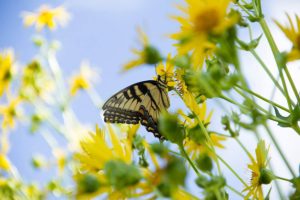
Just a couple of weeks more now, and we’ll be into spring. As the Earth’s tilt gradually places us more toward the Sun, we’re receiving a lot more solar energy than we did six weeks ago. The birds know it, and the hardy species that remain year round have been singing their spring songs for a while now. On nice days- chickadees, cardinals, nuthatches, house finches are all singing- I’m sure they all sense the light at the end of the tunnel.
Geese and ducks seem to move back and forth as the landscape freezes, then thaws, then freezes again during the last month or so. Owls and eagles are already eyeing up nesting sites, and horned larks, one of our first migrant songbirds, have already advanced north into our area and have been seen as north as Wausau. This wonderful flow of life, whose movements have been choreographed over hundreds of thousands of years, is just getting rolling again.
The first movement starts with birds which may cover hundreds or even thousands of miles. The second movement involves mammals, but their movement may be more vertical – up to the surface from winter dens, or down into the ground to produce litters of young, then up again to spread across the land. The same goes for plants, which transfer their energy from the ground, either sap or seeds, skyward to hoard the sun’s energy. Then it seems the insects get going when plant resources are available to sustain them.
Plants are the key. Even though we love colorful birds and cute furry mammals and beautiful butterflies, the health or even the presence of those is dependent on healthy plant communities. What’s happening among those boring old green plants, which seem to be everywhere, really determines what kind of animals will be present or absent. So people who care about nature tend to become gardeners, or farmers if you will, of the habitat on their property. Tending the habitat on your land, even if a small patch, will make a world of difference to some kind of wildlife.
Like all gardeners, this is the time of year to plan. Like every year, we hope you will consider planting something that helps native wildlife. Here are some plants that are easy to grow, yet benefit birds and butterflies.
Trees: oaks are ultimately the best, not for their acorns only, but also for insects attracted to them which feed songbirds. Red for dry areas, swamp-white for wet. Burr oak and white oak are also great, and the squirrels and turkeys will thank you no matter what species you plant. White cedar is great but deer eat them so they must be caged.White (including Black Hills) spruce and juniper provide cover and seeds and deer don’t like them. Birches provide seeds in winter, while apples and crabapples provide flowers for bees and fruit.
Shrubs: the spreading junipers provide berries and cover for birds. Red-osier dogwood is pretty and provides flowers and white berries that birds love. Various viburnums provide fruit, although European cranberry can be invasive. Please don’t plant Japanese barberry (Berberis), which is alien and very invasive on sandy soils. Chokeberry and serviceberry are also good fruit choices.
Wildflowers- Bees and butterflies need our help. Easy to grow natives include: common and gray-headed sunflower, coneflowers, blazing-star, wild bergamot (or bee balm), cup-plant (can be aggressive and large), penstemon, and of course milkweeds like common milkweed and butterflyweed. Some native grasses are bunch-forming and can be very attractive, like little blue-stem. One must limit weed competition when planting native wildflowers, especially at first, so some preparation over the summer might be needed before fall planting. There are many resources on how this can be done.
As I write, millions of seeds that were planted last fall lay dormant at Woodland Dunes, waiting to germinate in the coming seasons. Many were planted specifically to help pollinators and to help preserve the diversity of insect and bird life in our area. Thousands more trees and shrubs planted in the last three years also await the return of the growing season to help restore areas that were once filled with invasives. This kind of gardening, while it doesn’t put food on the table, nourishes the soul and helps the life that shares our world.
photo- tiger swallowtail feeding on cup-plant flower at Woodland Dunes, by Nancy Nabak
